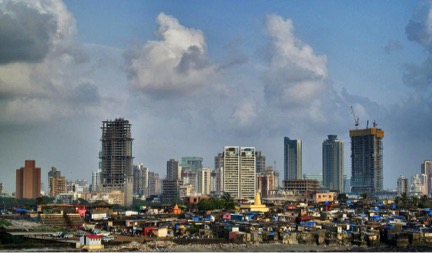 Source: Jonathan Hubbard, 2012
Source: Jonathan Hubbard, 2012Mumbai, India is comprised of seven islands separated from the mainland by the Thane Creek, Mahim River, and Harbor Bay, with the Arabian Sea to its west.  Mumbai is the largest city in India with a population of 20 million people, with a density of 19,700/km2 (UN-Habitat, 2011; Mumbai City District, 2011).  About 41.84% of Mumbaikars live in slums; Dharavi is one of the largest in Southeast Asia, with an approximate area spanning 2.4 km2 and a population density of ~300,000/km2 (UN-Habitat, 2011).  Mumbai is governed by the Municipal Corporation for Greater Mumbai.  The city is productive, with a diverse economy amounting to 7% of India’s GDP (Clark, G., Moonen, T., 2014).
The greatest hazards Mumbai faces are flooding and sea-level rise.  Mumbai is a low-lying, semi-tropical city where temperatures average around eighty degrees fahrenheit annually, and with seasonal variations characterized by the rainy season June to September, and dry months for the rest of the year.  A projected 30 to 80 centimeter rise in sea-level and 10 to 20% increase in cyclones, accompanied by less frequent, stronger rains will increase flood intensity and recurrence (Patankar, 2010).  Extreme weather events have occurred; in July 2005, 944 millimeter of rain fell in a 24-hour period, emanating in floods that killed over 1,000 people (De Sherbinin, A., Schiller, A., & Pulsipher, A., 2007).
Mumbai’s primary vulnerabilities are its topography, inadequate transit systems, and unsound infrastructure.  Built on a flat mangrove ecosystem, its antiquated public transit systems total >75% of the city’s motorized trips and do not have the capacity to withstand climatic changes and intensifying meteorologic events (Cropper, C., Bhattacharya, S., 2012).  In addition, Mumbai’s 100-year old drainage system is susceptible to saltwater deluge during storms, only to be exacerbated by rising sea-levels (Hallegatte, 2010).  These vulnerabilities highlight Mumbai’s risk, especially in informal settlements and near railways where sound infrastructure is lacking.
Mumbai has addressed some challenges that public transportation systems face.  Specifically, the Monorail Project, Mumbai Urban Transport Project, fare subsidies, and the construction of sixty-seven skywalks, which emphasize how important these systems are (Modi, 2010).  However, the infrastructure in place cannot accommodate the growing pressures from increasing capacity and climate change without upgrading.  It was estimated that $36 million invested in sea-level rise protection would reduce the economic impact of one-meter rise by $50 billion (TERI, 1996).  Change is slow, and fast and effective investments in infrastructural upgrades addressing sea-level rise near coasts and transit systems are essential to ensuring the proper functioning of Mumbai.
Mumbai has high risk, floods and sea-level rise pose the greatest risks to Mumbai‚Äôs public transit systems.¬† To respond to these risks, we recommend the establishment of an ‚ÄúIntegrated Transport Sustainability Management Department.‚Ä̬† This adaptation-focused interdepartmental agency will operate within the Municipal Corporation of Greater Mumbai.¬† This integrated agency will oversee (1) policy making and implementation, or more specifically, designing new zoning policies for railways and roads to minimize the impacts of flooding on mass transit; (2) stormwater management, including remediating waterways from waste sedimentation, which slows water flow intensifying flooding; removing impervious surfaces near railways to inhibit water logging (3) maintaining, adapting and upgrading transit systems (buses and railroad cars), and (4) facilitating communication and coordinating with other government bodies to align their goals to develop long-term sustainability-driven goals and maximize efficacy.
To summarize, Mumbai has extremely high risk.  Flooding and sea-level rise, accompanied by low-lying, antiquated public transit and drainage systems, and gradual governmental interventions provide a detailed look at the challenges Mumbai faces.  Mumbai’s public transit systems are among the most used in the world and require adaptation measures in response to climate change. Mumbai’s economic base offers potential for redirecting its urbanization as Mumbai continues to establish itself as a premier, global city.
This article is a product of Professor Shagun Mehrotra’s Climate Change and Cities class. Analysis is based on the Framework for City Climate Risk Assessment and Climate Change and Cities:First Assessment Report of the Urban Climate Change Research Network. Views expressed are entirely those of the authors. 
References
Clark, G., Moonen, T. (2014).¬† ‚ÄúMumbai: India‚Äôs Global City.‚Ä̬† A Case Study for the Global Cities Initiative: A Joint Project between Brookings and JPMorgan Chase. https://www.jpmorganchase.com/corporate/Corporate-Responsibility/document/gci_mumbai_02.pdf
Cropper, M., & Bhattacharya, S. (2012). Public Transport Subsidies and Affordability in Mumbai, India. Urban Studies Research, 2012(ID:865972), 7-7. doi:10.1155/2012/865972
De Sherbinin, A., Schiller, A., & Pulsipher, A. (2007). The vulnerability of global cities to climate hazards. International Institution for Environment and Development (IIED), 19(1), 39-64. doi:10.1177/0956247807076725
Hallegatte, S. et al. (2010), ‚ÄúFlood Risks, Climate Change Impacts and Adaptation Benefits in Mumbai: An Initial Assessment of Socio-Economic Consequences of Present and Climate Change Induced Flood Risks and of Possible Adaptation Options‚ÄĚ, OECD Environment Working Papers, No. 27, OECD Publishing. http://dx.doi.org/10.1787/5km4hv6wb434-en
Modi, D. (2010). Current Initiatives of Local Governments in India. UCLG ASPAC Congress 2010, Hamamatsu, 3, 74-74.
Mumbai City District: Census 2011 data (Mumbai City District Population Census 2011 and density). http://www.census2011.co.in/census/district/357-mumbai-city.html
Patankar, A., A. Patwardhan, J. Andharia, & V. Lakhani (2010). Mumbai City Report. Bangkok, Thailand: International Workshop on Climate Change Vulnerability Assessment and Urban Development Planning for Asian Coastal Cities
Shanghai Manual. (2010).  A Guide for Sustainable Urban Development in the 21st Century. United Nations Bureau International des Expositions.
TERI (Tata Energy Research Institute) (1996), ‚ÄúThe economic impact of a one-metre sea-level rise on the Indian coastline: method and case studies‚ÄĚ, Report submitted to the Ford Foundation.
UN_Habitat. (2011). Cities and the International Climate Change Framework. Chapter 2 in Cities and Climate Change.  Global Report on Human Settlements 2011.  London, UK: Earthscan. Pp.18.